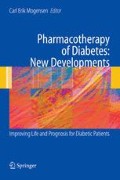Keywords: Diagnosis, IFG, IGT, classification, definitions.
Access this chapter
Tax calculation will be finalised at checkout
Purchases are for personal use only
Preview
Unable to display preview. Download preview PDF.
References
WHO Expert Committee on Diabetes Mellitus. Second Report. Technical Report Series 646. Geneva: WHO, 1980.
World Health Organization Study Group. Diabetes Mellitus. WHO Technical Report Series 727. Geneva: WHO, 1985.
World Health Organization. Definition, diagnosis and classification of diabetes mellitus and its complications. Report of a WHO consultation. Part 1: Diagnosis and classification of diabetes mellitus. Geneva: WHO, 1999.
World Health Organization. Definition and diagnosis of diabetes mellitus an intermediate hyperglycaemia. Report of a WHO/IDF Consultation. Geneva: WHO, 2006.
The Expert Committee on the diagnosis and classification of diabetes mellitus. Report of the expert committee on the diagnosis and classification of diabetes mellitus. Diabetes Care 1997;20:1183–1197.
The Expert Committee on the diagnosis and classification of diabetes mellitus. Follow-up report on the diagnosis of diabetes mellitus. Diabetes Care 2003; 26:3160–3167.
Alberti KG, Zimmet P, Shaw J. The metabolic syndrome-a new worldwide definition. Lancet 2005; 366:1059–1062.
Rusforth NB, Bennett PH, Steinberg AG, nBurch TA, Miller M. Diabetes in the Pima Indians: evidence of bimodality in glucose tolerance distributions. Diabetes 1971;20:756–65.
Lim T-O, Bakri R, Morad Z, Hamid MA. Bimodality in blood glucose distribution. Is it universal? Diabetes Care 2002;25:2212–2217.
Borch-Johnsen K, Colagiuri S, Vistisen D on behalf of the DETECT-2 collaboration. Is there a bimodal distribution of plasma glucose. American Diabetes Association Annual Scientific Meeting, 2006, Diabetes 2006;55(Suppl. 1):A19, Abstract 77.
The DECODE Study Group. Glucose tolerance and cardiovascular mortality: comparison of fasting and 2-hour diagnostic criteria. Archives of Internal Medicine 2001;161:397–405.
DECODE Study Group on behalf of the European Diabetes Epidemiology Study Group. Will new diagnostic criteria for diabetes mellitus change the phenotype of patients with diabetes? British Medical Journal 1998;317:371–375.
DECODE-Study Group. Glucose tolerance and mortality. Comparison of the WHO and ADA diagnostic criteria. Lancet 1999;354(9179):617–621.
Turner RC, Cull CA, Frighi V, Holman RR. Glycemic control with diet, sulfonylurea, metformin, or insulin in patients with type 2 diabetes mellitus: progressive requirement for multiple therapies (UKPDS 49). UK Prospective Diabetes Study (UKPDS) Group. JAMA 1999;281:2005–2012.
Kuzuya T, Matsuda A. Classification of diabetes on the basis of etiologies versus the degree of insulin deficiency. Diabetes Care 1997;20:219–220.
Bosi EP, Garancini MP, Poggiali F, Bonifacio E, Gallus G: Low prevalence of islet autoimmunity in adult diabetes and low predictive value of islet auto antibodies in the general adult population of northern Italy. Diabetologia 1999;42:840–844.
Ruige JB, Batstra MR, Aanstoot HJ, Bouter LM, Bruining GJ, De Neeling JN, Heine RJ: Low prevalence of antibodies to GAD65 in a 50- to 74-year-old general Dutch population. The Hoorn Study. Diabetes Care, 1997;20:1108–1110.
DECODE Study Group. Is fasting glucose sufficient to define diabetes? Epidemiological data from 20 European studies. Diabetologia 1999;42:647–654.
Pan X, Li G, Hu Y-H, Wang J, Yang W, An Z et al. Effects of diet and exercise in preventing NIDDM in people with Impaired Glukose Tolerance. The Da Qing IGT and Diabetes Study. Diabetes Care 1997;20:537–544.
Tuomilehto J, Lindstrom J, Eriksson JG, Valle TT, Hamalainen H, Ilanne-Parikka P et al. Prevention of type 2 diabetes mellitus by changes in lifestyle among subjects with impaired glucose tolerance. New English Journal of Medicine 2001;344:1343–1350.
Knowler WC, Barrett-Connor E, Fowler SE, Hamman RF, Lachin JM, Walker EA et al. Reduction of the incidence of type 2 diabetes with lifestyle intervention or metformin. New English Journal of Medicine 2002;346;393–403.
Chiasson JL, Josse RG, Gomis R, Hanefeld M, Karasik A, Laakso M. Acarbose for prevention of type 2 diabetes mellitus: the STOP-NIDDM randomized trial. Lancet 2002;359:2072–2077.
Glümer C, Vistisen D, Borch-Johnsen K, Colagiuri S; DETECT-2 Collaboration. Risk scores for type 2 diabetes can be applied in some populations but not all. Diabetes Care 2006(Feb);29(2):410–414.
Borch-Johnsen K, Colagiuri S, Balkau B, Glümer C, Carstensen B, Ramachandran A, Dong Y, Gao W. Creating a pandemic of prediabetes: the proposed new diagnostic criteria for impaired fasting glycaemia. Diabetologia 2004;47:1396–1402.
Glümer C, Jørgensen T, Borch-Johnsen K. Prevalence of diabetes and impaired glucose regulation in a Danish population – The Inter99 study. Diabetes Care 2003;26(8):2335–2340.
Khaw KT, Wareham N, Luben R, Bingham S, Oakes S, Welch A, Day N. Glycated haemoglobin, diabetes and mortality in men in Norfolk cohort of European Prospective Investigation of Cancer and Nutrition (EPIC-Norfolk). British Medical Journal 2001;322:15–18.
Jeppsson JO, Kobold U, Barr J, Finke A, Hoelzel W, Hoshino T, Miedema K, Mosca A, Mauri P, Paroni R, Thienpont L, Umemoto M, Weykamp C. Approved IFCC reference method for the measurement of HbA1c in human blood. Clinical Chemistry and Laboratory Medicine, 2002;40:78–89.
Davidson MB, Schriger DL, Peters AL, Lorber B. Relationship between fasting plasma glucose and glycosylated haemoglobin: Potential for false-positive diagnoses of type 2 diabetes using new diagnostic criteria. JAMA, 1999;281:1203–1210.
Author information
Authors and Affiliations
Editor information
Editors and Affiliations
Rights and permissions
Copyright information
© 2007 Springer Science+Business Media, LLC
About this chapter
Cite this chapter
Borch-Johnsen, K. (2007). New Definitions of Diabetes: Consequences. In: Mogensen, C.E. (eds) Pharmacotherapy of Diabetes: New Developments. Springer, Boston, MA. https://doi.org/10.1007/978-0-387-69737-6_2
Download citation
DOI: https://doi.org/10.1007/978-0-387-69737-6_2
Publisher Name: Springer, Boston, MA
Print ISBN: 978-0-387-69736-9
Online ISBN: 978-0-387-69737-6
eBook Packages: MedicineMedicine (R0)

